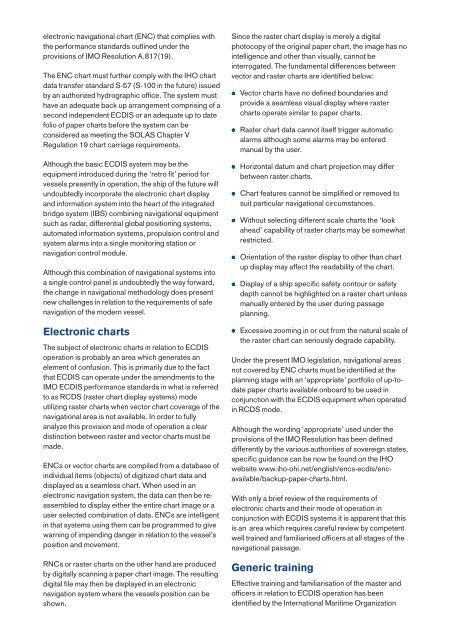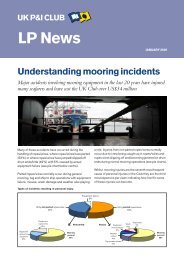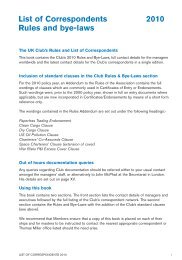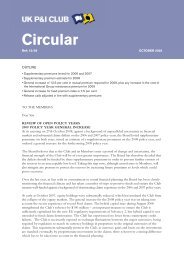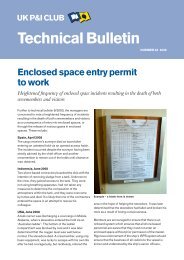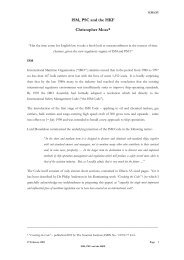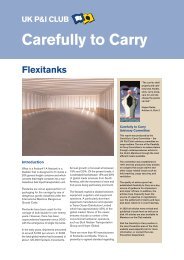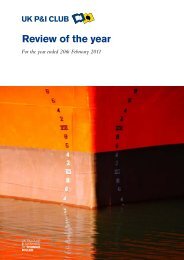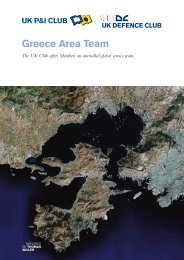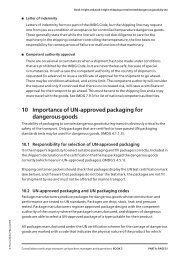ECDIS part 2 - UK P&I
ECDIS part 2 - UK P&I
ECDIS part 2 - UK P&I
You also want an ePaper? Increase the reach of your titles
YUMPU automatically turns print PDFs into web optimized ePapers that Google loves.
electronic navigational chart (ENC) that complies with<br />
the performance standards outlined under the<br />
provisions of IMO Resolution A.817(19).<br />
The ENC chart must further comply with the IHO chart<br />
data transfer standard S-57 (S-100 in the future) issued<br />
by an authorized hydrographic office. The system must<br />
have an adequate back up arrangement comprising of a<br />
second independent <strong>ECDIS</strong> or an adequate up to date<br />
folio of paper charts before the system can be<br />
considered as meeting the SOLAS Chapter V<br />
Regulation 19 chart carriage requirements.<br />
Although the basic <strong>ECDIS</strong> system may be the<br />
equipment introduced during the ‘retro fit’ period for<br />
vessels presently in operation, the ship of the future will<br />
undoubtedly incorporate the electronic chart display<br />
and information system into the heart of the integrated<br />
bridge system (IBS) combining navigational equipment<br />
such as radar, differential global positioning systems,<br />
automated information systems, propulsion control and<br />
system alarms into a single monitoring station or<br />
navigation control module.<br />
Although this combination of navigational systems into<br />
a single control panel is undoubtedly the way forward,<br />
the change in navigational methodology does present<br />
new challenges in relation to the requirements of safe<br />
navigation of the modern vessel.<br />
Electronic charts<br />
The subject of electronic charts in relation to <strong>ECDIS</strong><br />
operation is probably an area which generates an<br />
element of confusion. This is primarily due to the fact<br />
that <strong>ECDIS</strong> can operate under the amendments to the<br />
IMO <strong>ECDIS</strong> performance standards in what is referred<br />
to as RCDS (raster chart display systems) mode<br />
utilizing raster charts when vector chart coverage of the<br />
navigational area is not available. In order to fully<br />
analyze this provision and mode of operation a clear<br />
distinction between raster and vector charts must be<br />
made.<br />
ENCs or vector charts are compiled from a database of<br />
individual items (objects) of digitized chart data and<br />
displayed as a seamless chart. When used in an<br />
electronic navigation system, the data can then be reassembled<br />
to display either the entire chart image or a<br />
user selected combination of data. ENCs are intelligent<br />
in that systems using them can be programmed to give<br />
warning of impending danger in relation to the vessel’s<br />
position and movement.<br />
RNCs or raster charts on the other hand are produced<br />
by digitally scanning a paper chart image. The resulting<br />
digital file may then be displayed in an electronic<br />
navigation system where the vessels position can be<br />
shown.<br />
Since the raster chart display is merely a digital<br />
photocopy of the original paper chart, the image has no<br />
intelligence and other than visually, cannot be<br />
interrogated. The fundamental differences between<br />
vector and raster charts are identified below:<br />
% Vector charts have no defined boundaries and<br />
provide a seamless visual display where raster<br />
charts operate similar to paper charts.<br />
% Raster chart data cannot itself trigger automatic<br />
alarms although some alarms may be entered<br />
manual by the user.<br />
% Horizontal datum and chart projection may differ<br />
between raster charts.<br />
% Chart features cannot be simplified or removed to<br />
suit <strong>part</strong>icular navigational circumstances.<br />
% Without selecting different scale charts the ‘look<br />
ahead’ capability of raster charts may be somewhat<br />
restricted.<br />
% Orientation of the raster display to other than chart<br />
up display may affect the readability of the chart.<br />
% Display of a ship specific safety contour or safety<br />
depth cannot be highlighted on a raster chart unless<br />
manually entered by the user during passage<br />
planning.<br />
% Excessive zooming in or out from the natural scale of<br />
the raster chart can seriously degrade capability.<br />
Under the present IMO legislation, navigational areas<br />
not covered by ENC charts must be identified at the<br />
planning stage with an ‘appropriate’ portfolio of up-todate<br />
paper charts available onboard to be used in<br />
conjunction with the <strong>ECDIS</strong> equipment when operated<br />
in RCDS mode.<br />
Although the wording ‘appropriate’ used under the<br />
provisions of the IMO Resolution has been defined<br />
differently by the various authorities of sovereign states,<br />
specific guidance can be now be found on the IHO<br />
website www.iho-ohi.net/english/encs-ecdis/encavailable/backup-paper-charts.html.<br />
With only a brief review of the requirements of<br />
electronic charts and their mode of operation in<br />
conjunction with <strong>ECDIS</strong> systems it is apparent that this<br />
is an area which requires careful review by competent<br />
well trained and familiarised officers at all stages of the<br />
navigational passage.<br />
Generic training<br />
Effective training and familiarisation of the master and<br />
officers in relation to <strong>ECDIS</strong> operation has been<br />
identified by the International Maritime Organization


